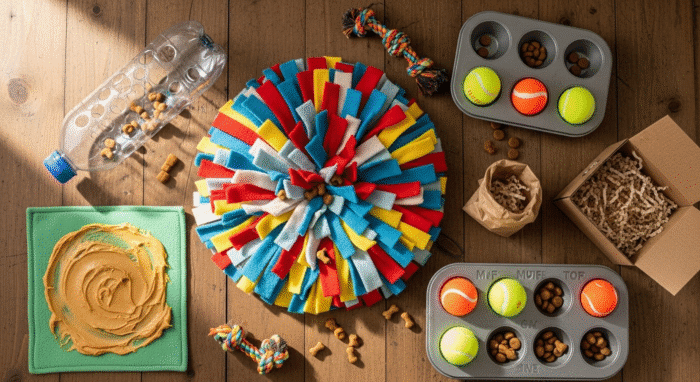Okay, let’s be honest. We’ve all been there. You’re trying to work, relax, maybe even sleep, and your dog is just… relentless. Tail wags that could power a small city, insistent nudges, and the dreaded deep sigh that translates to, “Entertain me!” You love them, of course. But sometimes, you need a break. And they need something to do. That’s where DIY dog enrichment comes in. But before we dive in, are you familiar with dog training? It is really important for mental stimulation.
Forget expensive toys or complicated contraptions (though those can be fun too!). Enrichment is about tapping into your dog’s natural instincts and providing outlets for their energy. We’re talking sniffing, chewing, problem-solving – the kind of stuff that makes their little doggy brains light up. Think of it as giving them a job, even if that job is just “find the treats hidden in this cardboard box.”
Here’s the thing: a tired dog is a good dog. And a mentally stimulated dog? Even better! They’re less likely to develop destructive behaviors, bark excessively, or generally drive you up the wall. Trust me, my own Labrador, Gus, used to be a master of canine chaos until I started incorporating daily enrichment activities. Now? He mostly just naps dramatically after a good puzzle session.
Table of Contents
Unleashing the Power of Sniffing: DIY Scent Games

Dogs have noses that are, like, a million times better than ours. Seriously, it’s insane. So, scent work is a fantastic way to tap into their natural abilities and tire them out. And the best part? It’s often super simple to set up.
One of my favorites is the classic “find the treat” game. Start by showing your dog a high-value treat (something they really love). Let them sniff it, get excited, the whole deal. Then, while they’re watching, hide it somewhere easy – under a towel, behind a chair leg. Encourage them to “find it!” with enthusiastic praise. As they get better, you can make the hiding spots progressively more challenging. I initially thought Gus would never get the hang of it, but now he practically vibrates with excitement when he hears the words “find it!”
But don’t stop there! Scent work can be so much more. You can create a “snuffle mat” by tying strips of fleece onto a rubber mat – hiding treats deep within the fleece keeps them engaged for ages. Or try scattering treats in your yard and letting them forage. Actually, that’s not quite right, you have to make sure there’s no danger, like toxic plants or sharp objects, lurking in the yard. You might be wondering, how long should I do this for? Start with 10-15 minutes and see how your dog responds. You can always increase the time as they get more experienced.
Chew Time: Safe and Engaging Chewing Activities
Chewing is another natural dog behavior. It’s not just about destroying your favorite shoes (though sometimes it feels that way!). It helps relieve stress, keeps their teeth clean, and provides mental stimulation. But finding safe and appropriate chew toys is crucial.
Rawhide chews? Eh, I’m not a huge fan, to be honest. They can be a choking hazard, and some dogs have trouble digesting them. Instead, I prefer durable rubber toys that can be stuffed with treats or peanut butter (make sure it’s xylitol-free!). Kongs are a classic for a reason. Freezing the stuffed Kong makes it last even longer. Online Games are just as good.
Another great option is bully sticks, but always supervise your dog while they’re chewing on them. And remember to choose the right size and hardness for your dog’s breed and chewing style. A tiny Chihuahua doesn’t need the same size bully stick as a giant Great Dane!
But, you know, I think it’s important to mention that some dogs aren’t big chewers. If your dog isn’t interested in chewing, don’t force it. There are plenty of other enrichment activities to try.
Puzzle Power: DIY Dog Puzzle Toys
This is where things get really fun. Puzzle toys challenge your dog’s problem-solving skills and provide mental stimulation. And you don’t have to spend a fortune on fancy store-bought ones. You can easily create your own using household items.
One of the simplest DIY puzzle toys is the muffin tin game. Place treats in some of the muffin tin cups, then cover each cup with a tennis ball. Your dog has to figure out how to remove the balls to get to the treats. It’s surprisingly challenging! And hilarious to watch.
Another great option is the cardboard box puzzle. Simply place treats inside a cardboard box, then crumple up newspaper or wrapping paper and stuff it in around the treats. Your dog has to dig and shred to find the goodies. Just make sure they don’t eat the paper!
Wait, there’s something even more interesting here. You can adjust the difficulty of these puzzles based on your dog’s skill level. Start with easy puzzles and gradually increase the challenge as they get better. That way, they stay engaged and don’t get frustrated. And don’t forget to provide plenty of encouragement and praise when they solve a puzzle! Think of it as a collaboration. And by the way you can get tips and tricks for traveling with your dog here.
DIY Dog Enrichment: FAQ
How do I know if my dog is bored?
Great question! Boredom in dogs can manifest in a variety of ways. You might notice increased barking, chewing on inappropriate items (like your furniture!), digging, or even excessive licking or grooming. Some dogs become restless and agitated, while others become withdrawn and lethargic. The key is to pay attention to your dog’s individual behavior and look for changes that might indicate they’re not getting enough mental or physical stimulation. If you’re unsure, consult with your veterinarian or a certified dog trainer. They can help you assess your dog’s needs and develop an appropriate enrichment plan.
Why is DIY dog enrichment important?
DIY dog enrichment is important for several reasons. First and foremost, it provides mental and physical stimulation, which is essential for a dog’s overall well-being. Boredom can lead to destructive behaviors, anxiety, and even depression in dogs. Enrichment activities help to keep their minds engaged and prevent these problems. Additionally, DIY enrichment is a cost-effective way to provide your dog with fun and challenging activities. You can use everyday household items to create puzzles, games, and scent work activities, saving you money on expensive store-bought toys. Finally, DIY enrichment is a great way to bond with your dog and strengthen your relationship. By working together to solve puzzles or play games, you’re building trust and creating positive associations.
How much time should I spend on DIY dog enrichment each day?
The amount of time you should spend on DIY dog enrichment each day depends on your dog’s individual needs and energy levels. Some dogs may only need 15-20 minutes of enrichment activities per day, while others may require an hour or more. Start by incorporating a few simple activities into your dog’s daily routine and observe their behavior. If they seem more relaxed and less destructive, you’re on the right track. If they’re still exhibiting signs of boredom, try adding more activities or increasing the duration of existing ones. Remember to be flexible and adjust your enrichment plan as needed to meet your dog’s changing needs. And don’t forget to factor in your own schedule and availability. The goal is to find a balance that works for both you and your dog.
What if my dog isn’t interested in enrichment activities?
It’s not uncommon for some dogs to be initially hesitant or uninterested in enrichment activities. The frustrating thing about this is, it’s a bit of trial and error to find out what kind of activities your dog enjoys. The key is to start slowly and make the activities as rewarding as possible. Use high-value treats that your dog loves, and provide plenty of praise and encouragement when they participate. If your dog seems overwhelmed, simplify the activity or break it down into smaller steps. For example, if they’re not interested in a complex puzzle toy, start with a simple treat-hiding game. You can also try introducing new activities gradually and observing your dog’s reaction. Some dogs may prefer scent work, while others may enjoy chewing or puzzle toys. Be patient and persistent, and eventually you’ll find the enrichment activities that your dog loves.
So, there you have it. DIY dog enrichment isn’t about spending a ton of money or becoming a canine activity guru. It’s about understanding your dog’s needs and providing them with opportunities to engage their minds and bodies. And who knows, you might even have some fun in the process!

